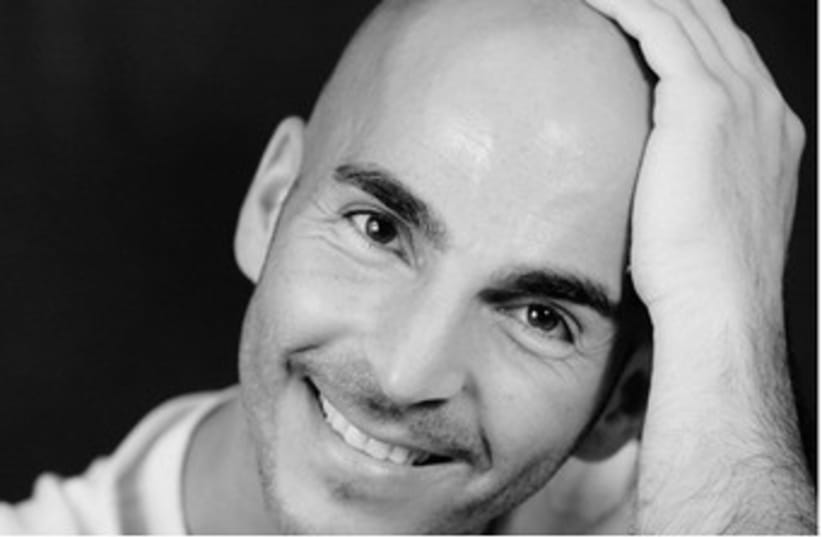
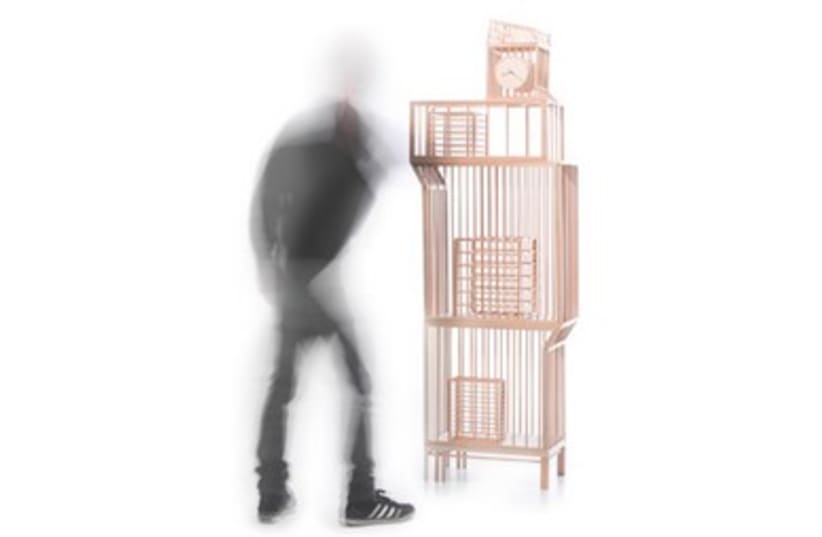
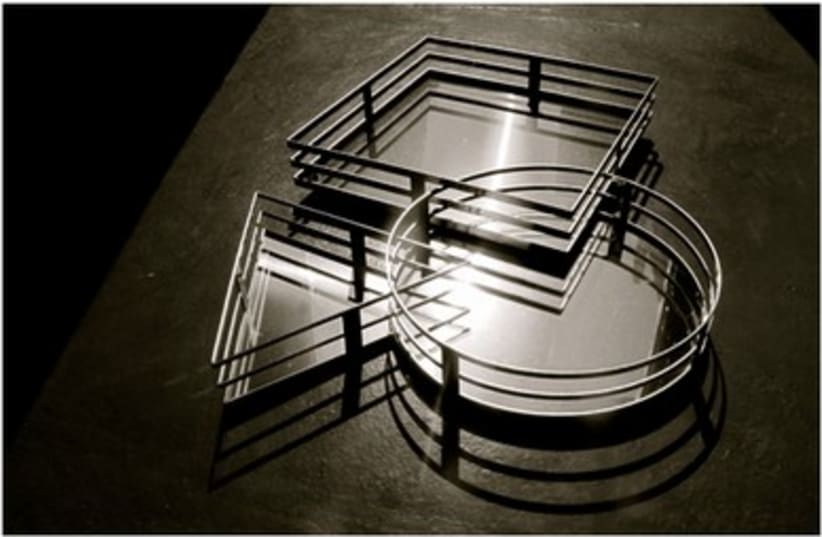
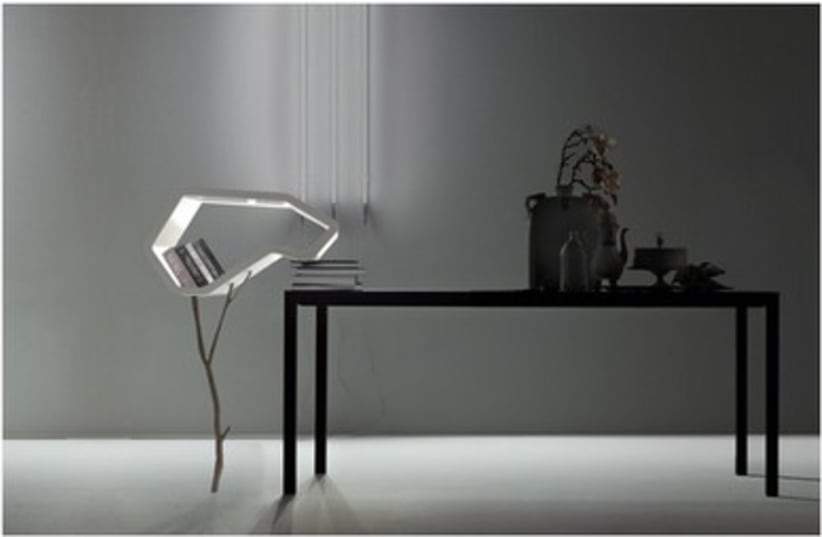
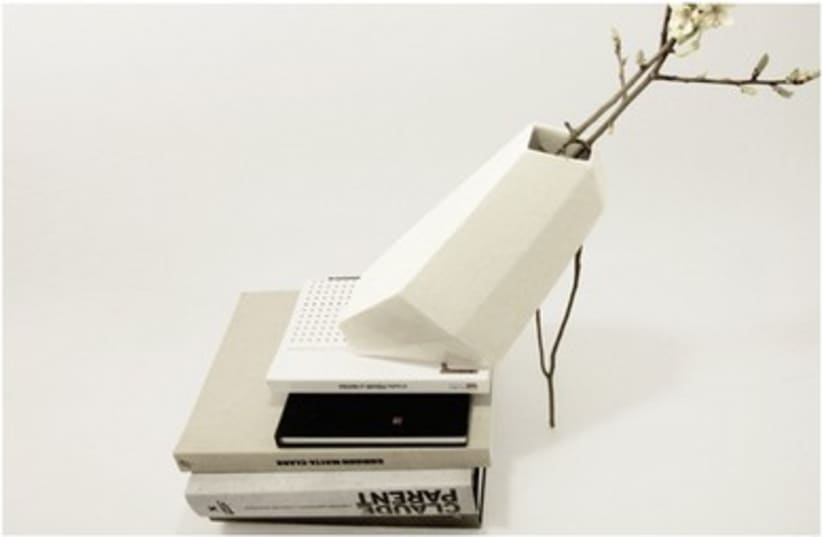
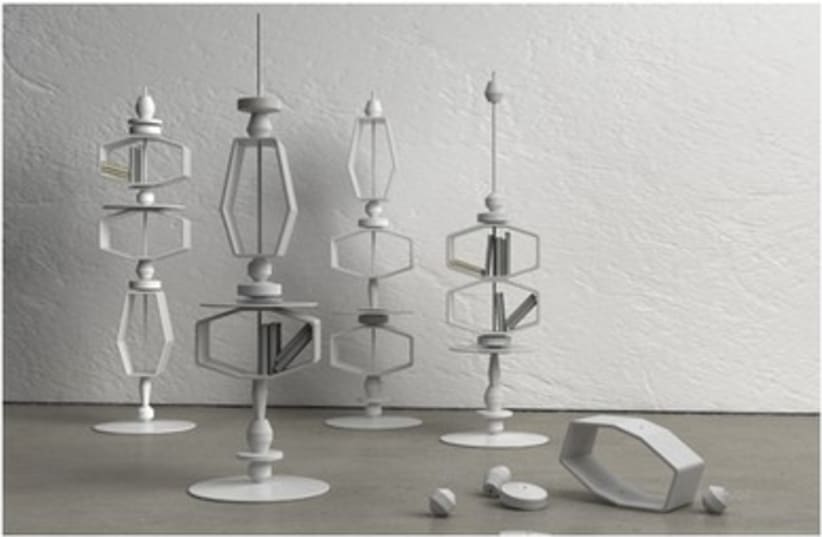

It seams like Jaim Telias is always on the go. From Chile, to Israel to Italy, this energetic guy knows exactly how to seize each moment and wherever he goes, he does his best to leave an industrially designed mark. As a curious person, Jaim observes his everyday surroundings and that’s when his design process begins to spread its wings. In the Boolean Plates, he plays with boundaries in order to create new forms and compositions. In El Castillo, a fantasy piece of furniture, he plays with the boundaries of reality and space. In Alè, a foliage wooden lamp, he ties and unties each leaf as to create his own custom shaped Alè. In Alef, a bent vase, he plays with balance and relations. In Caramelos, he plays with the structure of candy. Whether it’s a piece of furniture, a light fixture or just an ornament, it doesn’t hurt to have an exotic Hebrew or Spanish title to add to the mystery. And to think that most of his ideas came to mind, while in the shower. Can you tell me a little bit about your background?Well, it’s a bit difficult to tell a bit, but I’ll do my best.I was born in Chile and at the age of two, my family decided to move to Israel. In Israel we lived in different places such as Jerusalem and Afula. We also lived three years in a kibbutz, and then another 8 in a religious moshav. So I guess you can say all my life I’ve been on the move, being exposed to different places, cultures, religious views, styles and people. Growing up in Israel is where I learned to be independent from an early age, to be free and to explore my surroundings.At the age of 10, we moved back to Chile, actually it was my first real acquaintance with urban city life, at the beginning it was difficult to adjust, especially after living in Israel surrounded by nature. When I turned 18, I decided to return to Israel, this time on my own.A lot has happened since then. I met my beautiful wife, Michaela, graduated my Industrial design studies, and moved (again) to Italy, where Michaela’s family is, and to complete my Masters degree. Today we have a three year old daughter, and in the near future we are planning to move again, and this time for good, to Israel.This is the most brief background that I have ever given, as you can see I have a lot of stories to tell, and I think that it’s a good starting point for a designer, as that’s what we do. We tell stories.When did you first decide that you wanted to become a designer?To be honest, I’m still not sure that I want to be a designer.When I was getting close to finishing my mandatory army service, my father asked me, “Jaim…. what are you going to do after the army?” My father is a doctor, so you can guess the subtext. I was thinking of getting into theater and also heard from a friend about a profession where you can create whatever you want, use your hands, construct things and destruct things. I immediately realized what I had to do. All my life I liked to create and invent things, but I never thought that there was actually a profession that would allow me do it for a living.Where do you live, what do you like about it and how does it affect your creations?At the moment I live in Rome. I arrived here, because I realized that if I want to have a future as a designer living in Israel, I must first gain experience as a designer in Europe and create a network of contacts. Also, my wife’s family lives here.I like the historic contrast that exists in this city. I get to see it every time I go to my studio. Modern life overlapping with old architecture gives an interesting perspective.Give us a glimpse into a normal day in your life.I wake up at 5 a.m. and arrive at the market of Campo de Fiori, where I have a “basta” (Market stall) of jewels and souvenirs; I work there seven days a week. For the first hour or so while my employees open the “basta.” I work on my projects on my laptop, and later I join them and I work there until about 5 p.m. During the day, I always have my pen close by in case I’ll come up with any idea. From there, I head to my studio, where I work until about 8 p.m., then I go home, play with my daughter, hug my wife, eat, and at midnight I go to sleep.Can you briefly describe your process for creating a new design?It’s strange, I really don’t have a clear process. I’m a visual person, I remember everything that I see, so I have a lot of images floating around my head.My process starts randomly like in the shower, walking on the street or riding the metro. The images and thoughts come together to create something new. I then sketch the idea on my moleskin, or if I’m in the shower on the steamy mirror, just to get it down. After I feel that the idea has matured, I start solidifying it, first by extensive research to see if it has been done before (my ego), then at some point I start creating models; lots and lots of models. I usually leave the project for a while and let it grow on me and then go back for final modifications and that’s about it! Just so you know, I’m never satisfied with my final result.What are you most proud of professionally? And what has been your favorite project so far?I think that I haven’t gotten there, I’m very critical about my work and as soon I finish something I usually reject it. I only see the problems and immediately want to change it. Professionally, my best project so far, has been my daughter.What are you really good at? What are you really bad at?I’m really good at coming up with concepts and ideas. My ongoing traveling and moving around, forces me to be alone most of the time, which helps me develop a crazy, limitless and strange imagination.I’m not as good at turning these ideas into industrial projects, but I’m learning and improving every day. I began to understand myself better and that’s very important. I’m also very bad at sketching; at the beginning it bothered me when I saw other designers who sketch incredibly, but now I don’t care - I just sketch.What do you do to stay inspired and motivated to create?Well, I observe the smallest details and keep as much of them as my mind allows; even the perfect and imperfect relations and interactions between things or people. You can say that I’m fascinated by the perfect and imperfect and the fragile balance between them.Which place in the world most inspires you and why?I have been moving around all my life so I don’t have specific ties to places. I guess any place where I can move around, walk and observe. But, perhaps my shower is the right answer.
What are some other passions you have besides art and design?I love to read and I read a lot, a bit of everything. Also, I love the ocean; it’s the most relaxing place. And it might sound strange but I tend to stare a lot.I need to touch things, to feel their temperature, texture and composition in order to understand them. And of course, my family is a great passion of mine. The way my daughter looks at things, she’s teaching me to look at things for the first time, all over again and it’s inspiring and special at the same time.
Could you share with us your progression as a designer, compared to when you first started out, how have you changed since then?The most difficult and important part of growing as a designer is to understand who you are and what you want to do. Once you can answer these questions, you can find the right way to make it happen. I consider it all to be a life experiment that never ends. First you need to find a design formula that works for you and then spend all your life bettering it making it as simple as possible.I think I’ve started to understand my own ingredients but I’m still working on the formula itself. For example, I know that I don’t like curves (at least at this point of my life) but I am attracted to abstract geometric forms and lines, their sequence and rhythms and the space between them. I’ve realized that I like the imperfection more than the perfection. I am also intrigued by the interaction between the objects I design and their user, and how to achieve that in the most minimal way. That’s the story I want to tell.As you can see, I already have a vision and that’s a really good start, now I need to learn how to balance everything.
Lately you became part of TLV Express. How did the idea come up and what's behind it?Yes, and I’m very proud of it. I met last year at Promise-Design, where we were both displaying our work. Right from the beginning there was a very good vibe between us. A year later, close to the Milan Fair, I proposed to Asaf that we should create an international collective of designers, but it didn't work out because we didn't have a clear identity and the idea vanished even before it started.We still wanted to display in the Milan Fair, so I contacted the organizer of Ventura Lambrate (the most important district in the fair for the last 3 years) and they told me that we are too late, but despite that they are willing to give us a week to try and create a collective. So basically in no time, Asaf gathered the designers and together we managed to get our collection approved. We called it TLV Express since most of the items were from Tel Aviv, and Express because of the one week time frame we had to form the group. The biggest achievement of the group is that we created the very first Israeli collective ever that was independent from any school or company influence. The group’s impact was very strong in Milan and managed to create curiosity on what’s happening at the moment in the Israeli design scene.
Do you ever hit a creative block – if so, how do you get out of it?It happened only a few times. I guess I still need to become more famous to have more creative blocks. But when they happen, I just stop and move to something else and try not to think about it, which is hard for me.I’m lucky in the sense that I have good and strong distractions in my life, where I can free myself from thinking, like spending time with my daughter.What advice do you have for young designers who want to follow your path?Thank you for the compliment, but I feel like I still need to achieve a lot more in order to give advice, I still don’t know if it’s the correct path I'm on. Maybe the best advice is to follow your own path and most importantly is to be curious, don’t over think. Just do, the rest will follow, I think.
What was one of your biggest lessons learned since starting out?Trying to use the least amount of energy as possible. It took me a lot of time to understand that.What has contributed the most towards what you have achieved?Definitely my curiosity.At the age of 20, what did you think you were going to do “in life” – where do you see yourself in the future? Has your dream come true already?I definitely didn’t expect to live in Rome, to be married to an Italian and work in a market while designing. In the future I see myself living in Israel, having a big design atelier and maybe also a small design company.My father always told me that if I want something bad enough it will come true, and I’m a very persistent person.
Describe one thing or person that has influenced your designs the most.Definitely my daughter, she knows how to keep things simple, to be curious, to play and not take things to seriously.Every day I’m more convinced that kids are much more intelligent and philosophic then us. Then there comes a point in life where they lose that, and become like us.Read Einat’s blog and follow her design journey at http://www.designbreakonline.com/.Follow @JPost_Lifestyle
